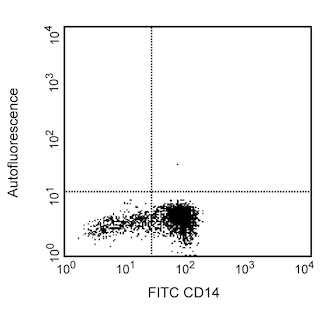Old Browser
Looks like you're visiting us from {countryName}.
Would you like to stay on the current country site or be switched to your country?


.png)

Flow cytometric analysis of human CD369 (Clec7A) expression on peripheral blood leucocytes. Whole blood was stained with either PE Mouse IgG2a, κ Isotype Control (Cat. No. 553457) or PE Mouse Anti-Human CD369 (Clec7A )antibody (Cat. No. 564471). Erythrocytes were lysed with BD Pharm Lyse™ Lysing Buffer (Cat. No. 555899). Contour plots showing the correlated expression patterns of CD369 (or Ig Isotype control staining) versus side light-scatter (SSC-A) characteristics were derived from gated events with the forward and side light-scatter characteristics of viable leucocytes. Flow cytometric analysis was performed using a BD LSRFortessa™ Cell Analyzer System.
.png)

BD Pharmingen™ PE Mouse Anti-Human CD369 (Clec7A)
.png)
규제 상태 범례
Becton, Dickinson and Company의 명시적인 서면 승인 없이는 사용 하실 수 없습니다.
준비 및 보관
제품 고시
- This reagent has been pre-diluted for use at the recommended Volume per Test. We typically use 1 × 10^6 cells in a 100-µl experimental sample (a test).
- Source of all serum proteins is from USDA inspected abattoirs located in the United States.
- An isotype control should be used at the same concentration as the antibody of interest.
- Caution: Sodium azide yields highly toxic hydrazoic acid under acidic conditions. Dilute azide compounds in running water before discarding to avoid accumulation of potentially explosive deposits in plumbing.
- For fluorochrome spectra and suitable instrument settings, please refer to our Multicolor Flow Cytometry web page at www.bdbiosciences.com/colors.
- Please refer to www.bdbiosciences.com/us/s/resources for technical protocols.
관련 제품





The 15E2 monoclonal antibody specifically binds to CD369 which is also known as CLEC7A (C-type lectin domain family 7 member A), Dectin-1 (Dendritic cell-associated C-type lectin 1), or BGR (Beta-glucan receptor). CD369 is a type II transmembrane C-type lectin that contains a C-terminal stalk with a carbohydrate recognition domain (CRD) in the extracellular domain, a transmembrane segment, and an ITAM containing cytoplasmic tail. This protein is highly expressed on dendritic cells. It is also expressed on B cells, monocytes, eosinophils, mast cells, macrophages, endothelial cells, and is lowly expressed on some subsets of T cells. CD369 binds to beta-glucan polymers and functions as a pattern recognition receptor in innate immune response to fungal and bacterial pathogens. The 15E2 antibody can reportedly stimulate dendritic cells to costimulate immune responses.

개발 참고 자료 (5)
-
Hermanz-Falcon P, Arce I, Roda-Navarro P, Fernandez-Ruiz E. Cloning of human DECTIN-1, a novel C-type lectin-like receptor gene expressed on dendritic cells. Immunogenetics. 2001; 53(4):288-295. (Biology). 참조 보기
-
Ni L, Gayet I, Zurawski S, et al. Concomitant activation and antigen uptake via human dectin-1 results in potent antigen-specific CD8+ T cell responses. J Immunol. 2010; 185(6):3504-3513. (Immunogen: ELISA, Flow cytometry, Fluorescence microscopy, Functional assay, Immunofluorescence, Stimulation). 참조 보기
-
Sobanov Y, Bernreiter A, Derdak S, et al. A novel cluster of lectin-like receptor genes expressed in monocytic, dendritic and endothelial cells maps close to the NK receptor genes in the human NK gene complex. Eur J Immunol. 2001; 31(12):3493-3503. (Biology). 참조 보기
-
Willment JA, Gordon S, Brown GD. Characterization of the human beta -glucan receptor and its alternatively spliced isoforms. J Biol Chem. 2001; 276(47):43818-43823. (Biology). 참조 보기
-
Yokota K, Takashima A, Bergstresser PR, Ariizumi K. Identification of a human homologue of the dendritic cell-associated C-type lectin-1, dectin-1. Gene. 2001; 272(1-2):51-60. (Biology). 참조 보기
Please refer to Support Documents for Quality Certificates
Global - Refer to manufacturer's instructions for use and related User Manuals and Technical data sheets before using this products as described
Comparisons, where applicable, are made against older BD Technology, manual methods or are general performance claims. Comparisons are not made against non-BD technologies, unless otherwise noted.
For Research Use Only. Not for use in diagnostic or therapeutic procedures.
Report a Site Issue
This form is intended to help us improve our website experience. For other support, please visit our Contact Us page.